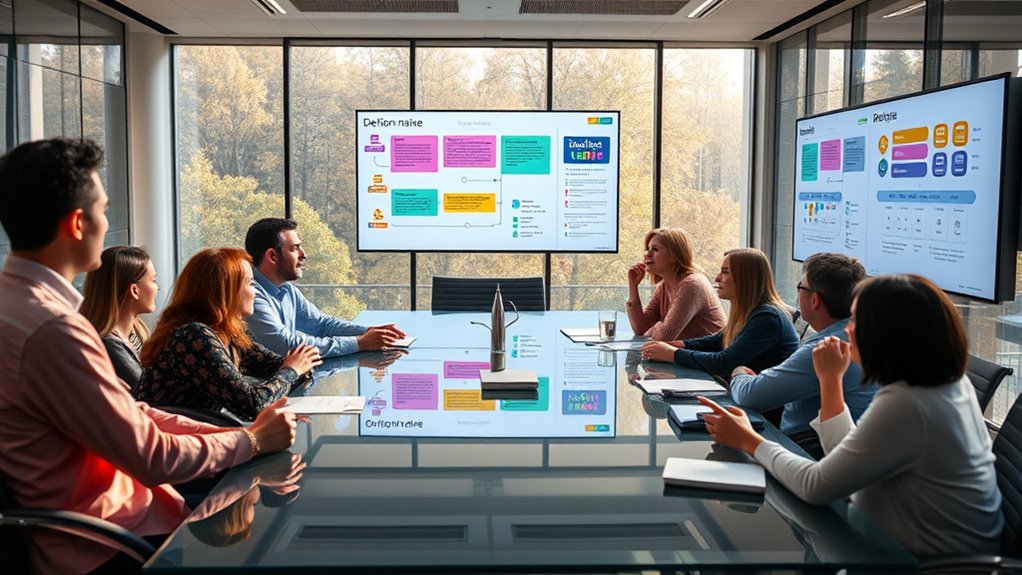Effective checks and balances in decision-making frameworks help you democratize innovation by promoting inclusive participation, transparency, and accountability. These frameworks encourage diverse voices, prevent dominance by any single group, and support ethical, culturally sensitive choices. By establishing clear roles, fostering collaboration, and guiding responsible development, you can guarantee your innovation process is fair and sustainable. Continuing will reveal how organizations can implement these principles to create more equitable and responsible advances.
Key Takeaways
- Implement multi-layered oversight and diverse stakeholder participation to prevent dominance and promote fairness in innovation processes.
- Foster transparent, inclusive decision-making frameworks that adapt to cultural contexts and encourage broad community engagement.
- Establish clear roles, responsibilities, and communication channels to ensure accountability and balanced contributions.
- Incorporate participatory design and feedback mechanisms to empower diverse voices and reduce bias.
- Use emerging tools like AI and collaborative platforms to enhance transparency, accountability, and ethical oversight in innovation.
The Role of Checks and Balances in Promoting Fair Innovation

How do checks and balances guarantee that innovation remains fair and inclusive? They ensure equity considerations are prioritized by creating multiple layers of oversight, preventing any single group from dominating decision-making. This process encourages diverse voices, addressing cultural influences that shape perceptions of fairness. By involving stakeholders from varied backgrounds, checks and balances help identify biases rooted in cultural norms, fostering more inclusive solutions. They also promote accountability, making sure innovations serve a broad spectrum of communities rather than reinforcing existing inequalities. When decision-making power is distributed, it reduces the risk of marginalization. Additionally, integrating AI ethics considerations into oversight mechanisms ensures responsible development. Ultimately, these mechanisms ensure that innovation reflects shared values and respects cultural differences, promoting fairness and inclusivity in the development process.
Core Principles of Democratic Decision-Making Frameworks

You play a key role in ensuring everyone’s voice is heard through inclusive participation methods. Clear and transparent decision processes build trust and keep everyone informed. When you focus on these core principles, you create a fairer and more collaborative innovation environment. Emphasizing technology choices such as projectors and display systems can further support diverse perspectives and enhance collective decision-making.
Inclusive Participation Methods
Inclusive participation methods form the foundation of democratic decision-making frameworks by making certain that diverse voices are actively involved in shaping innovation. You can achieve this through participatory design, which invites stakeholders directly into the creation process, fostering a sense of ownership and relevance. Stakeholder engagement is essential, as it brings together different perspectives, experiences, and expertise, enriching decision outcomes. By involving community members, users, and experts early on, you ensure that solutions address real needs and avoid biases. These methods promote transparency, trust, and accountability, empowering all participants to influence decisions meaningfully. Ultimately, inclusive participation creates a more equitable and responsive innovation environment where everyone’s voice matters and contributes to shaping the future.
Transparent Decision Processes
Transparent decision processes are crucial for fostering trust and legitimacy within democratic innovation frameworks. When you prioritize decision transparency, you enable stakeholders to see how choices are made, reducing suspicion and increasing confidence. Engaged stakeholder participation is essential; it ensures diverse perspectives are considered and that everyone understands the reasoning behind decisions. Clear communication about the process—who’s involved, criteria used, and how input influences outcomes—strengthens trust and accountability. By openly sharing information, you create an environment where stakeholders feel valued and empowered to contribute. Furthermore, understanding the Cookie Usage policies helps ensure that data collection respects user privacy and enhances transparency. Ultimately, transparent decision processes help democratize innovation by making the process visible, fair, and inclusive, ensuring that all voices are heard and that decisions reflect collective interests.
Examples of Frameworks Enhancing Inclusivity and Transparency

Have you ever wondered how some decision-making frameworks promote greater inclusivity and transparency? One effective example is stakeholder engagement, which actively involves diverse groups in the process, ensuring multiple perspectives are heard. This approach fosters trust and shared ownership of decisions. Cultural adaptation also plays a pivotal role; frameworks tailored to specific cultural contexts help remove barriers and encourage participation from all community members. For instance, some organizations adapt decision processes to respect local norms, language preferences, and values, making participation more accessible. These frameworks create an environment where everyone’s voice counts, reducing biases and increasing transparency. By engaging stakeholders meaningfully and adjusting to cultural nuances, you build inclusive systems that democratize innovation and promote fair, open decision-making. Incorporating elements like community-oriented design can further enhance the effectiveness of these frameworks.
Benefits of Implementing Balanced Decision Processes in Innovation

Implementing balanced decision processes in innovation guarantees that diverse perspectives are considered, leading to more robust and sustainable outcomes. By integrating ethical considerations, you guarantee that innovations align with moral values and social responsibilities, fostering trust and integrity. Recognizing cultural influences helps prevent biases and encourages solutions that respect different backgrounds and worldviews. This approach promotes fairness, reduces risks of unintended harm, and enhances acceptance across communities. When decision-making is balanced, you gain deeper insights, improve problem-solving, and create innovations that are more inclusive and adaptable. Additionally, understanding various brewing methods can inform more thoughtful product development and implementation. Ultimately, embracing these frameworks leads to smarter, more responsible innovations that resonate globally, strengthening your organization’s reputation and long-term success.
Strategies for Integrating Checks and Balances in Organizational Structures

You can reinforce organizational checks and balances by establishing clear decision rights that define who makes what choices. Encouraging cross-functional collaboration ensures diverse perspectives are considered and risks are balanced. Together, these strategies create a more democratic structure that supports innovation without sacrificing accountability. Incorporating AI-powered decision support tools can further enhance transparency and data-driven governance.
Clear Decision Rights
Clear decision rights are essential for fostering innovation within organizations by ensuring that responsibilities and authority are well-defined. When everyone understands who holds the power to make specific choices, you facilitate efficient stakeholder engagement and streamline processes. Clear roles help prevent overlaps and conflicts, enabling faster decision-making. Incorporate ethical oversight by establishing boundaries for decision authority, ensuring that choices align with organizational values and regulatory standards. This clarity promotes accountability and trust, as team members know whom to approach for approvals or concerns. When decision rights are transparent, it becomes easier to identify gaps or overlaps, allowing you to adjust structures as needed. Additionally, understanding the concept of Prophetic Dreams can inspire innovative thinking by encouraging openness to new insights and perspectives. Ultimately, well-defined decision rights empower teams to innovate confidently while maintaining checks and balances that uphold integrity.
Cross-Functional Collaboration
How can organizations foster effective innovation while maintaining necessary checks and balances across departments? The key lies in promoting interdepartmental synergy through cross-functional collaboration. By encouraging teams from different areas to work together, you create a culture of collaborative leadership that balances expertise with oversight. This approach helps prevent siloed decision-making and ensures diverse perspectives are integrated into the innovation process. Establish clear communication channels and shared goals to align efforts while preserving autonomy within each department. Regular cross-departmental meetings and joint accountability reinforce checks and balances without stifling creativity. Additionally, understanding the antioxidant properties of various honey types exemplifies how diverse insights can enrich decision-making. Ultimately, fostering such collaboration enables your organization to innovate confidently, knowing that multiple viewpoints are considered and that responsible decision-making is embedded across functions.
Challenges and Limitations of Democratizing Innovation

While democratizing innovation offers numerous benefits, it also presents significant challenges that can hinder its effectiveness. Power dynamics often influence who truly has a voice in decision-making, limiting genuine participation from marginalized or less-established contributors. This imbalance can reinforce existing hierarchies rather than disrupt them. Additionally, innovation barriers like lack of resources, technical expertise, or access to necessary tools can prevent many from contributing meaningfully. These obstacles may lead to token participation, reducing the diversity of ideas and slowing progress. Overcoming these challenges requires intentional efforts to create equitable platforms and support systems that empower all participants, ensuring that democratization fosters genuine collaboration rather than superficial involvement. Otherwise, the process risks perpetuating inequalities rather than transforming them. Incorporating diverse design options and materials can help broaden participation and foster more inclusive innovation.
Future Trends in Collaborative and Responsible Innovation

As the landscape of democratized innovation evolves, emerging trends emphasize the importance of collaboration and responsibility. You’ll see increased focus on leveraging emerging technologies like AI, blockchain, and open-source platforms to foster inclusive participation. These tools enable diverse stakeholders to contribute meaningfully, enhancing collective innovation. Ethical considerations are becoming central, guiding responsible use of technology and ensuring that innovation benefits society without harm. Expect frameworks to prioritize transparency, accountability, and stakeholder engagement, reducing risks of bias or misuse. Additionally, understanding affiliate disclosures and privacy policies becomes essential for maintaining trust in collaborative environments. Future trends also include developing policies that balance rapid technological advancement with societal values. By embracing these approaches, you can help create an environment where innovation remains accessible, ethical, and aligned with broader social good.
Frequently Asked Questions
How Do Checks and Balances Impact Innovation Speed?
When considering how checks and balances impact innovation speed, you find that they promote collaborative consensus, ensuring diverse perspectives are valued. This process may slow decision-making initially, but it effectively mitigates risks, leading to more sustainable breakthroughs. By involving multiple stakeholders, you create a balanced environment that fosters thoughtful innovation while reducing potential setbacks, ultimately leading to well-rounded, resilient solutions that stand the test of time.
Can Democratizing Innovation Hinder Competitive Advantage?
Imagine a garden where everyone plants a seed—democratizing innovation spreads ideas widely, which can sometimes feel like watering down the soil’s richness. While collaborative leadership promotes transparency benefits and inclusive growth, it may slow your competitive advantage if decision-making becomes too diluted. However, embracing diverse perspectives can also create a resilient ecosystem, helping you adapt and thrive despite the potential hurdles of open innovation.
What Role Do Cultural Differences Play in Decision Frameworks?
You should consider how cultural differences influence decision frameworks, especially in cross-cultural collaboration. These differences shape how teams approach decision making, encouraging diversity that can lead to more innovative solutions. By understanding and respecting varied perspectives, you foster decision-making diversity, which enhances creativity and problem-solving. Embracing cultural differences helps create inclusive environments where diverse ideas thrive, ultimately strengthening your organization’s ability to adapt and innovate globally.
How Are Conflicts Resolved Within Democratic Innovation Models?
When conflicts arise in democratic innovation models, you typically resolve them through consensus building, ensuring all voices are heard and considered. You recognize that power dynamics influence whose opinions carry more weight, so you actively work to balance these forces. By fostering open dialogue and collaborative decision-making, you create an environment where conflicts are addressed constructively, strengthening the collective effort and promoting fair, inclusive innovations.
Are There Industries Where Checks and Balances Are Less Effective?
Have you considered that some industries might have less effective checks and balances? In sectors like finance or healthcare, regulatory gaps and industry silos can hinder oversight, making it harder to guarantee fair, transparent innovation. These gaps often create blind spots where unchecked decisions can occur, reducing accountability. So, isn’t it essential to develop tailored frameworks that bridge these silos and close regulatory gaps, fostering more effective governance?
Conclusion
By embracing checks and balances, you become the guardian of fair innovation—like a lighthouse guiding ships safely through turbulent waters. These frameworks illuminate the path to inclusivity and transparency, ensuring that progress doesn’t overshadow ethics. As you integrate these principles into your organization, you create a sturdy ship built for responsible exploration, steering the future of innovation with integrity. Ultimately, your commitment to balanced decision-making keeps the beacon shining bright for all to follow.









